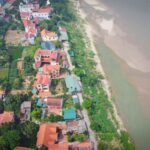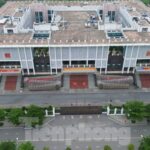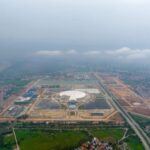On May 19, 2025, coinciding with the 135th birth anniversary of President Ho Chi Minh (May 19, 1890 – May 19, 2025), the construction of the Tu Lien Bridge project, with a total investment of over VND 20,000 billion, will officially commence. The construction is scheduled to take place during the period of 2025 – 2027.
The Tu Lien Bridge has been grabbing attention as this Group A project is not only a key traffic infrastructure in Hanoi but is also expected to become a new architectural landmark, beautifying the face of the thousand-year-old capital.

Illustrative image of Tu Lien Bridge. Photo: Hanoi Department of Planning and Architecture
The project has been approved by the Hanoi People’s Committee in Decision No. 1850 dated April 1, 2025. As per the construction plan, the Tu Lien Bridge is a cable-stayed bridge spanning the Red River, connecting Tay Ho District and Dong Anh District in Hanoi. The bridge will feature 6 lanes for motor vehicles, 2 mixed lanes, and 2 pedestrian lanes.
With a total length of 11.5 km [including the main bridge of 1 km + the two bridgeheads of 4.5 km + the connecting road in Dong Anh district of 6 km], the Tu Lien Bridge, upon completion, will become the longest bridge across the Red River.
The Sustainability Symbol of the Billion-Dollar Bridge
Aside from setting records as the longest bridge across the Red River and its billion-dollar investment, the Tu Lien Bridge also stands out due to its unique design.

Perspective of Tu Lien Bridge.
Firstly, the Tu Lien Bridge will be one of the most beautiful bridges in Vietnam, associated with the image of a flying dragon. As per the design, the two main bridge towers are designed to resemble four dragons flying towards the sky, inspired by the name “Thang Long – Rồng Bay” – a symbol closely linked to the thousand-year history of Thang Long – Hanoi.
Secondly, the Tu Lien Bridge, with the symbol of the “Four Dragons” soaring into the sky, represents Hanoi’s aspiration for far-reaching development during the period of green and sustainable urbanization. The Tu Lien Bridge will help reduce the burden on the Long Bien, Chuong Duong, and Nhat Tan bridges, thereby alleviating traffic congestion and reducing CO2 emissions from vehicles, which is one of the causes of air pollution in Hanoi.
Thirdly, this cable-stayed bridge across the Red River has the potential to promote sustainable tourism. By connecting the Co Loa area (Dong Anh) – a national historical relic – with the center of Hanoi, it will encourage the development of cultural and spiritual tourism. These tourism activities are oriented towards a sustainable model, minimizing environmental impacts and raising community awareness about natural resource protection.
Fourthly, the Tu Lien Bridge will be built to withstand an earthquake of magnitude 8. Regarding this aspect, according to international bridge and road experts, for a bridge to withstand an earthquake of magnitude 8 (a very strong level, causing severe damage), special measures such as seismic dampers, deep foundations, and high-strength materials are required.
Seismic dampers have been used worldwide in various structures to mitigate the impact of earthquakes by dissipating seismic energy. They work by absorbing and converting the energy from ground motion into heat, thereby reducing movement and potential damage to the structure.
The Tu Lien Bridge is not just a transportation infrastructure but also a symbol of Hanoi’s remarkable development in this new era. With a combination of modern design, advanced technology, and strategic significance, this bridge is expected to contribute to the transformation of the urban landscape, boost the economy, and bring Hanoi closer to its goal of becoming a modern and sustainable megacity.
“Streamlining Hanoi: A Comprehensive Plan to Reduce 400 Commune-Level Administrative Units”
As of 2025, the country has undergone a transformation, resulting in a streamlined administrative structure. There are now 3,321 commune-level administrative units, consisting of 2,636 communes, 672 wards, and 13 special districts. This new structure has led to a significant reduction of 6,714 units compared to the pre-transformation era, achieving an impressive decrease of 66.91%.
The Crumbling Coast: Homes at Risk as the Phong Van Seawall Falls into Disrepair.
“The homes of over 40 families are at risk as severe cracks appear and widen in their walls and foundations. This crisis has unfolded over a year since the Phong Van embankment in Ba Vi, Hanoi, suffered a landslide. The once-stable homes now teeter on the edge of disaster, with each day bringing new fears of collapse and ruin.”
The Capital: A $22.7 Million Administrative Center Project to House Commune Offices
The Dong Anh District Administrative Center, spanning almost 5 hectares, is currently under construction with a total investment of over VND 530 billion. Once completed, the center will serve as the new administrative headquarters for Dong Anh District, providing a modern and efficient workspace for local government operations.
The Green Trail: A Collaborative Effort by Three North Central Provinces to Create an Eco-Friendly Inter-Regional Tourism Experience
The collaboration between the three north-central provinces of Ninh Binh, Thanh Hoa, and Nghe An to develop sustainable green tourism trails is a groundbreaking initiative. By working together, these provinces are not only conserving their natural resources but also revolutionizing regional branding, enhancing visitor experiences, and attracting tourists from far and wide.
The Ultimate Guide to Investing in Boutique Gate: Capturing the Expo City Tourist Wave
Under the directive of the Prime Minister to host The Grand Expo at Vinhomes Global Gate to commemorate 80 years of national independence, the commercial real estate market in Northeast Hanoi has witnessed a surge in activity.





















